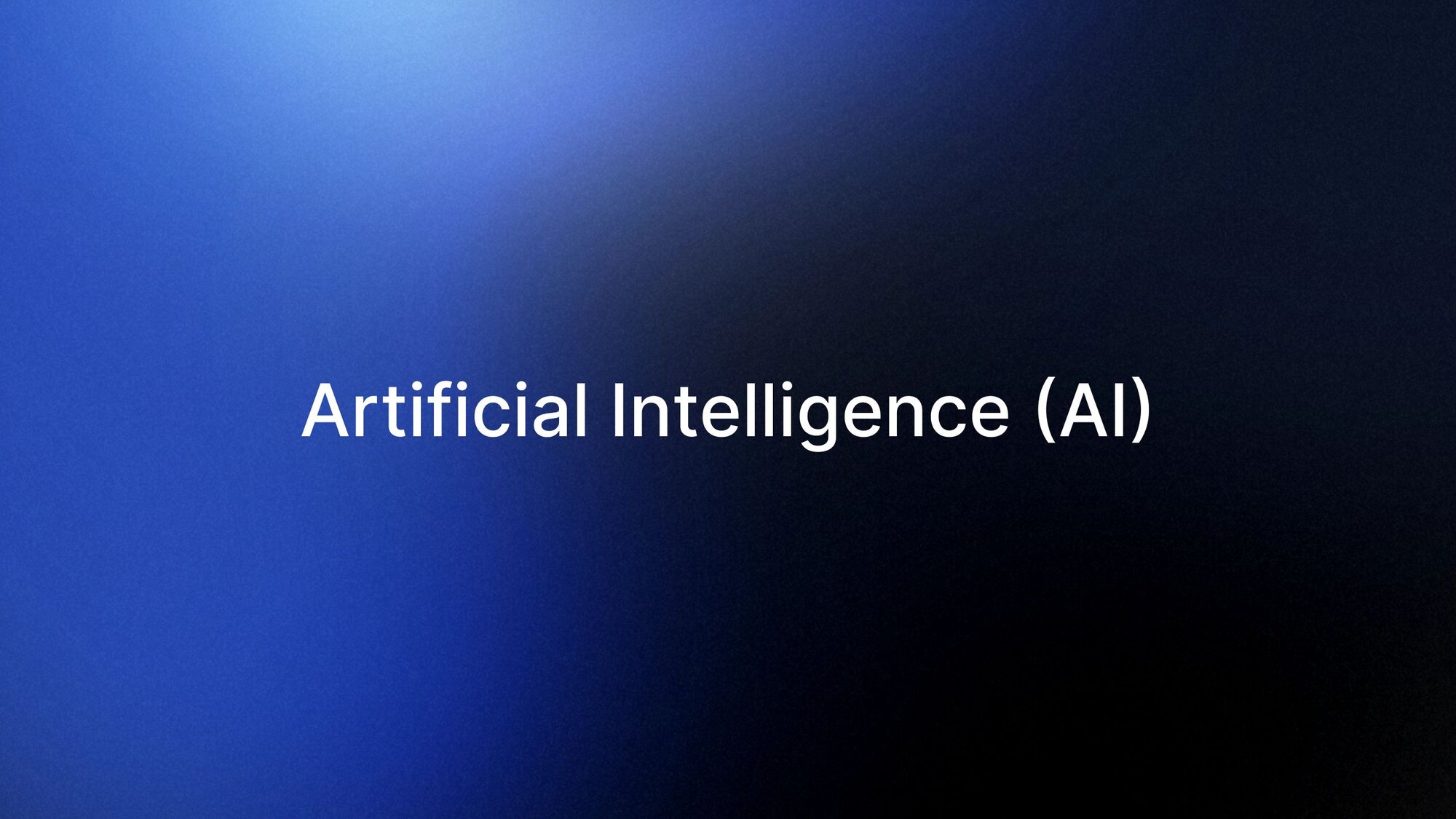<- Back to Glossary
Artificial Intelligence (AI)
Definition, types, and examples

What is artificial intelligence (AI)?
Artificial Intelligence, commonly abbreviated as AI, refers to the simulation of human intelligence in machines that are programmed to think and learn like humans. These machines are designed to mimic cognitive functions such as problem-solving, learning, and pattern recognition. AI systems can adapt to new situations, process vast amounts of data, and perform tasks that typically require human intelligence.
Definition
Artificial Intelligence is a branch of computer science focused on creating intelligent machines capable of performing tasks that usually necessitate human intelligence. These tasks include visual perception, speech recognition, decision-making, language translation, and more. AI systems use algorithms and statistical models to analyze data, recognize patterns, and make predictions or decisions without explicit programming for each specific task.
Types
There are several types of AI, often categorized based on their capabilities and likeness to human intelligence:
1. Narrow or Weak AI: Designed for a specific task, like voice assistants or image recognition systems. Examples include Siri, Alexa, and facial recognition software.
2. General or Strong AI: Hypothetical AI with human-like cognitive abilities across a wide range of tasks. This type doesn't exist yet but is a goal of many researchers.
3. Artificial General Intelligence (AGI) or Superintelligence: A theoretical form of AI that would surpass human intelligence in virtually all domains.
Other classifications include:
- Reactive Machines: Basic AI that reacts to current situations without past memory.
- Limited Memory: AI that can use past experiences to inform future decisions.
- Theory of Mind: AI that can understand human emotions and social interactions (still theoretical).
- Self-Aware AI: AI with human-like consciousness (purely theoretical at this point).
History
The concept of artificial intelligence has roots in ancient mythology, but its modern history began in the mid-20th century:
1950: Alan Turing proposes the Turing Test, originally called the imitation game, a method for determining if a machine can exhibit intelligent behavior.
1956: The term "Artificial Intelligence" is coined at the Dartmouth Conference, marking the field's official beginning.
1960s-1970s: Early AI winter due to limitations in computing power and algorithms.
1980s: Expert systems gain popularity, leading to an AI boom.
1990s-2000s: Machine learning becomes more prominent, with advances in neural networks and probabilistic reasoning.
2010s: Deep learning breakthroughs, particularly in areas like computer vision and natural language processing.
2020s: Large Language Models (LLMs) and transformer architectures revolutionize AI capabilities in language understanding and generation.
Examples of Artificial Intelligence (AI)
AI has permeated various aspects of modern life:
- Virtual Assistants: Siri, Alexa, and Google Assistant use natural language processing and machine learning.
- Recommendation Systems: Netflix, Amazon, and Spotify employ AI to suggest content based on user preferences.
- Autonomous Vehicles: Companies like Tesla and Waymo use AI for self-driving capabilities.
- Healthcare: AI assists in disease diagnosis, drug discovery, and personalized treatment plans.
- Finance: AI algorithms power high-frequency trading and fraud detection systems.
- Gaming: AI opponents in video games and AI-generated game content.
- Art and Creativity: AI-generated art, music, and writing, such as DALL-E for image creation, AI Checker tools, and GPT models for text generation.
Tools and Websites
Several tools and websites showcase AI capabilities or allow users to interact with AI:
1. OpenAI's ChatGPT: A conversational AI model capable of engaging in human-like dialogue.
2. Julius: A popular new AI tool which performs well for data analysis and math solving.
3. Google's DeepMind: Known for AlphaGo and protein structure prediction with AlphaFold.
4. TensorFlow and PyTorch: Open-source libraries for machine learning and deep learning development.
5. Hugging Face: A platform for sharing and collaborating on machine learning models.
6. Midjourney and DALL-E: AI-powered image generation tools.
7. Jasper.ai and Copy.ai: AI writing assistants for content creation.
In the Workforce
AI is reshaping the workforce across various industries:
- Automation: AI-powered robots and systems are automating repetitive tasks in manufacturing, logistics, and customer service.
- Augmentation: AI tools are enhancing human capabilities in fields like data analysis, medical diagnosis, and software development.
- New Job Creation: The AI industry is creating new roles such as AI ethicists, machine learning engineers, and data scientists.
- Skill Shifts: There's an increasing demand for workers with AI-related skills and digital literacy.
- Ethical Considerations: As AI becomes more prevalent, there's a growing need for policies addressing AI's impact on employment and worker rights.
Frequently Asked Questions
Will AI replace human jobs?
AI will likely automate certain tasks, but it's also expected to create new jobs and augment human capabilities in many fields.
Can AI become conscious?
Currently, there's no scientific consensus on machine consciousness. It remains a topic of philosophical and scientific debate.
How is AI different from machine learning?
Machine learning is a subset of AI focused on algorithms that improve through experience. AI is a broader field that includes machine learning and other approaches to creating intelligent machines.
What are the ethical concerns surrounding AI?
Key concerns include privacy, bias in AI decision-making, accountability for AI actions, and the potential for AI to be used in warfare or surveillance.
What recent developments have significantly advanced AI?
The development of transformer architectures in Large Language Models (LLMs) has revolutionized natural language processing. Additionally, advancements in specialized hardware, such as NVIDIA's GPUs, have dramatically accelerated AI computations, enabling more complex models and faster training times.
How is AI impacting climate change efforts?
AI is being used to optimize energy grids, improve climate modeling, and develop more efficient technologies. However, the energy consumption of large AI models is also a growing concern.
What role does AI play in cybersecurity?
AI is used both for detecting and preventing cyber threats, as well as for creating more sophisticated cyberattacks, leading to an ongoing technological arms race.
